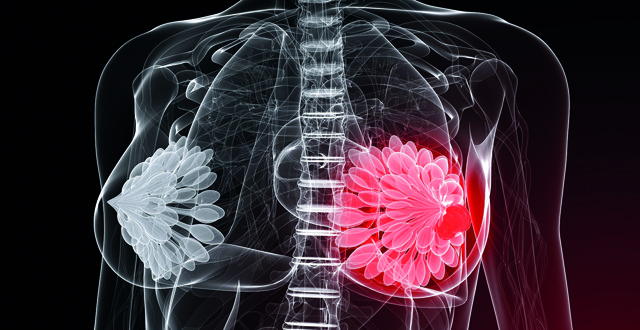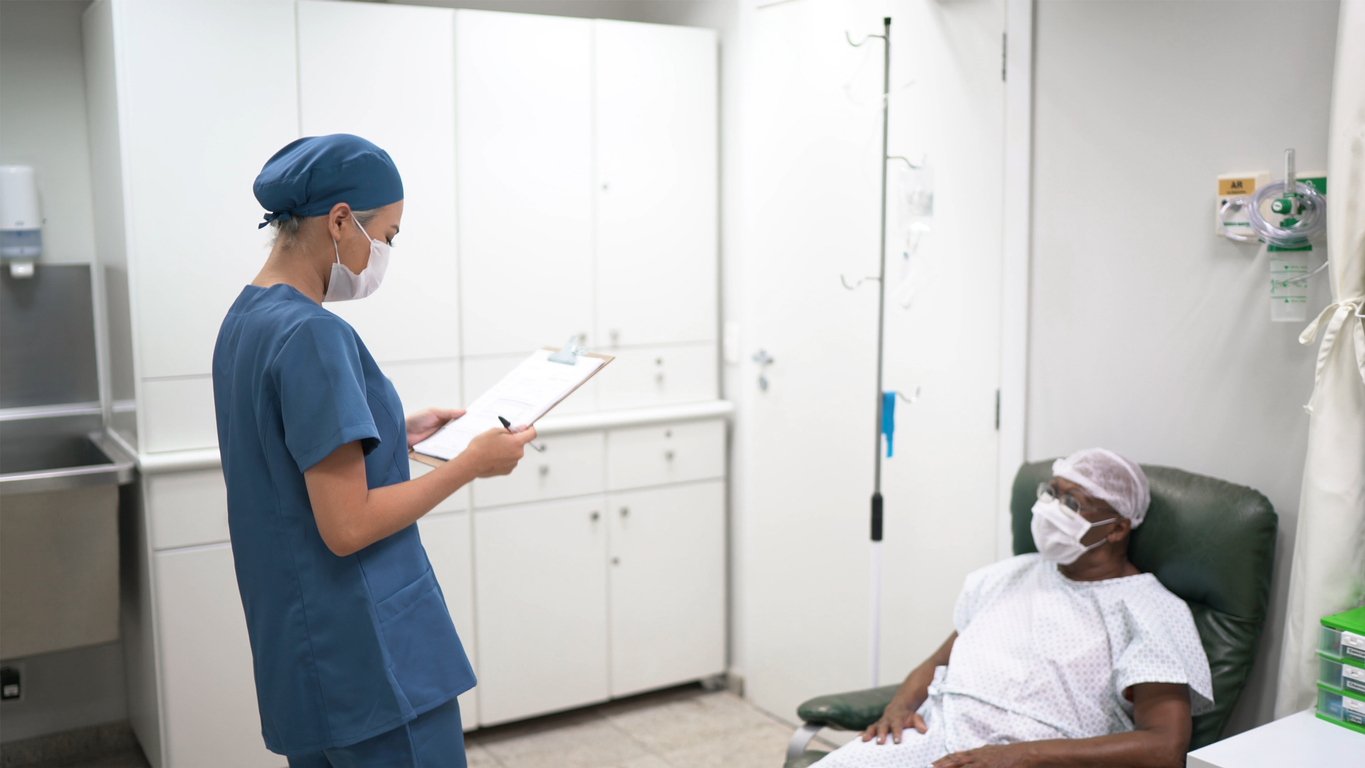According to the National Cancer Registry Ireland (NCRI), the estimated annual incidence of breast cancer in Ireland is 2,919 cases per year, with approximately 694 deaths caused by breast cancer each year. For women in Ireland, the lifetime risk of developing breast cancer is one-in-11.
Breast cancer mortality is decreasing. The latest report from the NCRI shows that the five-year net survival rate for female breast cancer in Ireland is just over 83 per cent, an increase from 71 per cent in the 1990s. This is likely related to the discontinuation of hormone replacement therapy (HRT) use, as well as the contribution of national screening programmes and increased awareness.
<h3 class=”subheadMIstyles”>Screening</h3>
Some 77 per cent of female breast cancers are diagnosed over the age of 50 years. The median age of diagnosis of breast cancer is 62.
BreastCheck is the national breast cancer screening programme in Ireland. It currently offers mammograms for women aged 50-to-64 years old. This age group is being extended so that all women currently being screened will be offered screening until age 69 years. Overall, approximately one-third of female breast cancers are detected by screening.
Since the initial implementation of BreastCheck in 2000, the proportion of cases of breast cancer presenting through screening has increased, rising from 7 per cent in 2000, to 28 per cent in 2010 for invasive cases and from 32 per cent to 54 per cent for the same years, respectively, for <em>in situ</em> carcinoma.
<h3 class=”subheadMIstyles”>Symptoms</h3>
Approximately one-third of breast cancers are detected by abnormal mammography at screening. Outside of screening, the most common presentation of breast cancer is a breast mass. It is possible for a breast mass to be clinically palpable and mammographically occult; therefore, triple assessment breast clinics are an important referral point.
Characteristics of a malignant mass include hardness, immobility and border irregularity.
Signs of locally-advanced disease include axillary lymphadenopathy and skin findings such as erythema, skin thickening and skin dimpling.
Signs of metastatic disease may also be apparent at initial presentation and are dependent on the organ involved, most commonly bone, liver, lung and brain.
<h3 class=”subheadMIstyles”>Risk factors</h3>
Family history is strongly associated with an increased risk for developing breast cancer. If a woman has a first-degree relative with a history of breast cancer, then her risk is increased two-fold compared with the general population. If a woman has two affected first-degree relatives, then her risk is increased three-fold.
The age of the affected relative at diagnosis is also important, with risk increasing with relatives diagnosed in their 30s.
Between five-to-10 per cent of breast cancers are believed to be hereditary. Approximately 20 per cent of women with a family history of breast cancer have a mutation in the breast cancer susceptibility genes 1 and 2 (BRCA1 and BRCA2), inferring an increased lifetime risk of breast cancer, as well as ovarian cancer.
A woman’s reproductive history is also important when considering her risk of developing breast cancer. Factors including nulliparity/low parity, late age at first pregnancy, late natural menopause, early menarche, oral contraceptive use and HRT use are associated with an increased risk.
Other factors that increase a woman’s risk of developing breast cancer include high body mass index (BMI), alcohol intake, ionising radiation exposure, benign breast disease and high socioeconomic status.
<h3 class=”subheadMIstyles”>Treatment</h3>
The treatment of breast cancer is generally dependent on multiple factors, including type of breast cancer, stage of the disease, sensitivity to hormones, HER2 status and patient’s overall health, performance status and preference. A complete review of all treatment options is beyond the scope of this article; however, a brief overview of the modalities of treatment include:
<strong><em>Surgery</em></strong>
In patients with stage I-III breast cancer, surgery is the most important modality of curative treatment. Surgery may involve breast-conserving surgery or may require mastectomy, depending on the size and location of the tumour and whether there is coexisting <em>in situ</em> disease or multifocal disease.
The status of the axillary lymph nodes is important for staging, management and prognosis. An axillary lymph node dissection is considered if the sentinel node biopsy is positive for malignancy, or if there are multiple positive nodes in the clinical context.
The discussion of surgical options, management of the axillae, immediate or delayed reconstruction and the potential for breast radiation are important considerations for the patient and for the multidisciplinary group and are generally well planned prior to definitive surgery.
<strong><em>Radiotherapy</em></strong>
Radiotherapy is widely used in breast cancer, particularly in the setting of stage I-III disease with curative intent and also in stage IV disease with palliative intent. In general, most patients with breast-conserving surgery are considered for radiotherapy. This adjuvant treatment is given five days a week for three-to-six weeks’ duration. Palliative radiotherapy is frequently used in advanced breast cancer patients. It is utilised to reduce pain or decrease tumour mass effect on adjacent structures for symptomatic control.
<strong><em>Chemotherapy</em></strong>
Systemic chemotherapy does not provide a benefit in every breast cancer diagnosis. Oncologists have become more refined in the approach to systemic treatment and utilise tools such as the pathology and biomarkers, age and performance status, mathematical decision models, and genomic tumour profiling to decide on chemotherapy benefit. The most recent advancement in lymph node-negative, HER2-negative breast cancer is to offer oncotype testing. This is a tumour profiling test to determine the benefit of chemotherapy. In women with low- or intermediate-risk oncotype scores, chemotherapy is less likely to provide benefit and influences the treatment decision.
Standard adjuvant chemotherapy regimens combine a taxane, cyclophosphamide with or without an anthracycline, depending on the clinical and genomic risk features. Neoadjuvant chemotherapy (NAC) refers to chemotherapy delivered before surgery and is considered for patients with locally-advanced or inflammatory breast cancer (IBC). NAC, compared to adjuvant chemotherapy, is associated with higher rates of breast conservation, with equivalent rates of overall survival and locoregional recurrence, provided that surgery is part of the received treatment.
In metastatic breast cancer, European Society for Medical Oncology (ESMO) guidelines recommend sequential monotherapy as a preferred choice, starting with endocrine therapy if at all possible. Combination chemotherapy should be reserved for patients with rapid clinical progression, life-threatening visceral metastasis or need for rapid symptom/disease control.
<strong><em>Endocrine therapy</em></strong>
Endocrine therapy should be offered to patients with hormone receptor-positive breast cancer in the adjuvant setting and continued for at least five years. In metastatic breast cancer, it is continued until there is evidence of progressive disease.
In premenopausal women, tamoxifen remains the standard of care. If it is not tolerated, one option is to suppress ovarian function chemically or surgically and introduce an aromatase inhibitor. For postmenopausal women, multiple endocrine therapy options exist, including aromatase inhibitors, oestrogen receptor antagonists, and irreversible steroidal inhibitors.
Resistance to endocrine therapy can develop in any stage of breast cancer, and in this setting there are new options to extend a patient’s time on oral endocrine therapy, including the addition of everolimus to endocrine therapy, or the addition of a CDK4/6 inhibitor, such as palbociclib or ribociclib.
These are new, oral targeted therapies that are well tolerated in metastatic breast cancer patients. There is no significant alopecia, there is a lower risk of infection, and patients do not require infusions, thus adding to their quality-of-life.
<strong><em>Targeted therapy</em></strong>
The HER2 protein is an overexpressed receptor signature in breast cancer and is considered a relevant biomarker for treatment. Trastuzumab is a monoclonal antibody that targets HER2 and is the first targeted HER2 drug that was approved by the US FDA in 1998. Other drugs in clinical use that target HER2 include pertuzumab (intravenous), lapatinib (an oral inhibitor), and TDM-1 (an antibody-drug conjugate).
Triple-negative breast cancers (TNBC) lack oestrogen, progesterone and HER2 receptors. TNBC tend to be a subtype of aggressive breast cancers with no targetable mutations. In recent months, PARP-inhibitors have been approved for use in America for patients with BRCA-mutated breast cancers, many of which are triple-negative subtype.
<h3 class=”subheadMIstyles”>Breast cancer updates from recent conferences</h3>
<strong><em>Risk reduction</em></strong>
Numerous studies have associated high BMI with increased breast cancer risk. According to data presented by Chlebowski et al at the 2017 San Antonio Breast Cancer Symposium (SABCS), postmenopausal women who lose weight may have a significantly reduced chance of developing breast cancer. Of the 61,335 patients enrolled in the study, 3,061 developed invasive breast cancer during an average of 11.4 years of follow-up. Compared to women with stable weight, those who lost weight (≥5 per cent weight change) were 12 per cent less likely to develop breast cancer. Weight loss of ≥15 per cent was associated with a 37 per cent reduction in breast cancer risk. Although weight gain (≥5 per cent weight change) was not associated with an increased overall breast cancer risk, it was associated with more than a 50 per cent increased risk of triple-negative breast cancer.
<strong><em>Fertility</em></strong>
Many women diagnosed with breast cancer, especially younger women, are concerned about the ability to have children after cancer treatment. Some breast cancer treatments can cause temporary infertility or make it harder to get pregnant after treatment ends. Other treatments, especially certain chemotherapy regimens, can cause early menopause and infertility. A meta-analysis of individual patient data from five randomised clinical trials provided a high level of evidence that treatment with gonadotropin-releasing hormone analogue (GnRHa) during chemotherapy could safely and effectively protect ovarian function and potentially preserve fertility in premenopausal women receiving chemotherapy for early-stage breast cancer, according to a study presented by Lambertini et al at 2017 SABCS. The study found that the premature ovarian insufficiency rate in the GnRHa group was 14.1 per cent vs 30.9 per cent in the control group; patients in the GnRHa group had a 62 per cent less risk of developing premature ovarian insufficiency as compared to those treated with chemotherapy alone. Some 37 patients in the GnRHa group had at least one post-treatment pregnancy during the follow-up period vs 20 patients in the control group.
<strong><em>Endocrine therapy</em></strong>
After surgery, women diagnosed with hormone-receptor positive breast cancer usually take adjuvant hormonal therapy to reduce the risk of recurrence. There are several types of hormonal therapy. Tamoxifen is one of the most well-known. The aromatase inhibitors have been shown to be more effective at reducing recurrence risk in postmenopausal women and are used more often than tamoxifen to treat women who have gone through menopause.
In recent years, published data reports that extending the adjuvant endocrine setting from five to 10 years provides additional benefit in terms of reducing the risk of breast cancer recurrence. Presentations at the 2017 SABCS showed an additional two years of an aromatase inhibitor is sufficient, while an additional five years in the extended adjuvant setting led to more clinical fractures.
<strong><em>Immunotherapy</em></strong>
An early study presented at 2017 SABCS hints that pembrolizumab, an immune checkpoint inhibitor, may offer benefits for certain metastatic HER2-positive breast cancers.
<strong><em>Metastatic</em></strong>
HER2-positive breast cancer is trastuzumab resistant because most patients with HER2-positive breast cancer receive trastuzumab in the adjuvant or neoadjuvant setting. In the PANACEA study, investigators examined if immunotherapy can work in patients with advanced HER2-positive breast cancer that is resistant to trastuzumab. The combination of pembrolizumab and trastuzumab may offer benefits to people diagnosed with metastatic HER2-positive breast cancer with high levels of tumour-infiltrating lymphocytes (TILs) that has stopped responding to trastuzumab.
<strong><em>Other agents</em></strong>
Three cyclin-dependent kinase (CDK) 4/6 inhibitors have been approved by the FDA for treatment of ER-positive, HER2-negative metastatic breast cancer in combination with an endocrine therapy. It has been shown that the estimated progression-free survival (PFS) was improved to 23.5 months, compared to 13.5 months for those treated with the combination CDK4/6 inhibitor and endocrine therapy.
For women with BRCA1 or 2 mutations diagnosed with breast cancer, the EMBRACA trial utilising talazoparib was presented at 2017 SABCS. This trial reported that treatment with a PARP inhibitor, which blocks one of the enzymes that assists DNA repair, resulted in longer PFS than chemotherapy.













Leave a Reply
You must be logged in to post a comment.